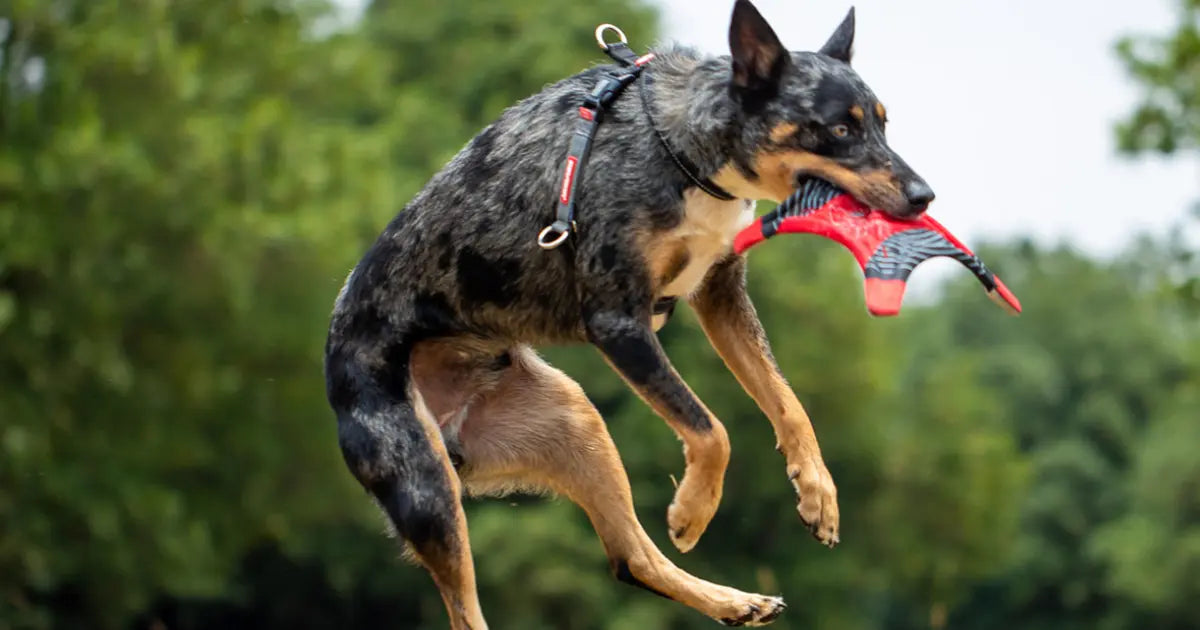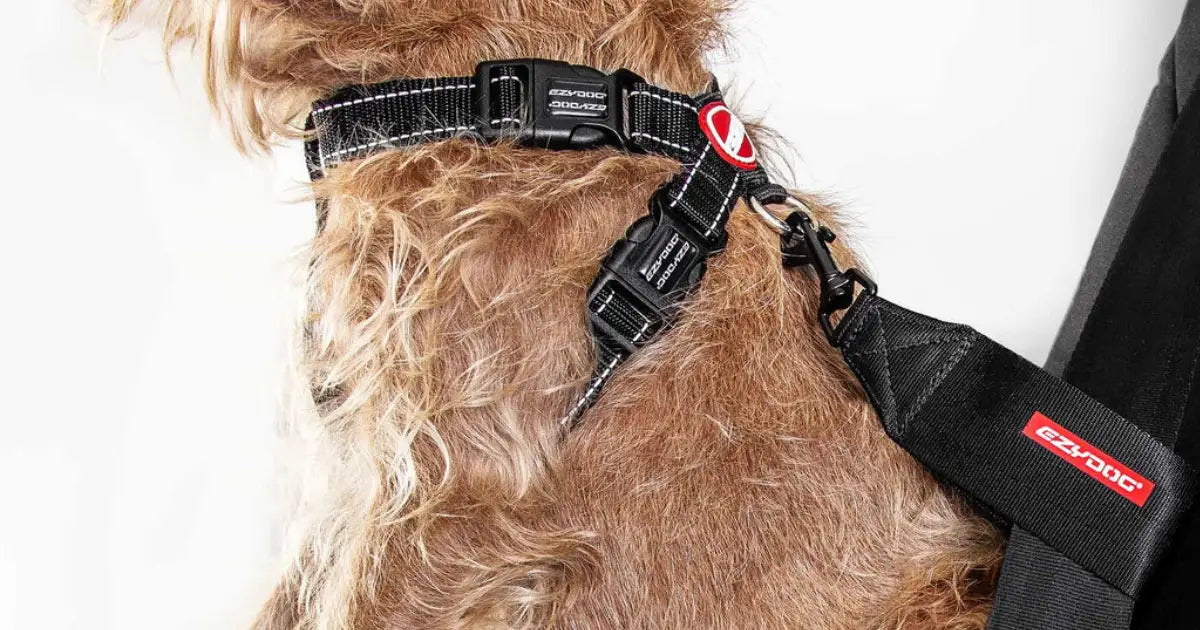
How to Stop Your Dog Pulling on the Lead
Does your dog drag you down the street every time you step outside? Pulling on the lead is one of the most common challenges dog owners face, but the good news is that it can be fixed with the right training techniques and supportive gear. By understanding why dogs pull, choosing the right equipment, and following consistent training, you can turn stressful walks into calm, enjoyable outings.
If you’re considering supportive gear to make walks easier, our Dog Harness Collection features options designed to help manage pulling safely.
Why Dogs Pull on the Lead?
Dogs don’t pull to annoy you — they simply walk faster than we do and are driven by curiosity. Every new smell or distraction becomes a reward, and if pulling gets them closer to it, they learn that it works.
Puppies and young dogs often pull because they haven’t yet learned proper leash manners, while energetic or working breeds naturally move at a faster pace. This behaviour can become dangerous when combined with a collar, as it puts pressure on the neck and can lead to choking or injuries.
Essential Gear to Help Stop Pulling
The right equipment doesn’t replace training, but it makes it much easier to teach your dog loose-lead walking. A no-pull harness is one of the best options for managing strong pullers. Harnesses with a front clip gently redirect your dog’s movement without causing strain, while padded designs improve comfort during longer walks.

-
Our Non-Pull Dog Harnesses, such as the Crosscheck and X-Link, are excellent for training dogs that pull.
-
Puppies and small dogs benefit from lightweight, easy-fit harnesses like our Step-In Dog Harnesses, which are gentle on delicate necks.
-
If your dog is still growing, Adjustable Harnesses help you maintain a snug, secure fit. For better control during training, pair the harness with a double-ended lead.
-
Our Dog Training Leads allow you to attach to both the front and back clips of the harness for greater stability.
You may also check out our complete guide on choosing the right dog harnesses for your furry mate.
Step-by-Step Training: How to Stop Dog Pulling on Lead
Stopping pulling takes consistency and patience, but these methods work for most dogs when practised daily.
Step 1: Start Indoors or in a Quiet Area
Begin training in a calm, distraction-free space, such as your living room or garden, before attempting busy streets. This allows your dog to focus on you rather than reacting to exciting smells, people, or other dogs.
Attach the harness and lead, let your dog wander a little, and immediately reward any moment when the lead stays loose. Keeping early sessions short — even 5–10 minutes — helps build good habits without overwhelming them.
Step 2: Reward Loose Lead Behaviour
Dogs repeat rewarding behaviours. The moment your dog walks beside you with a slack lead, reward them with a treat, cheerful praise, or even a quick game with a toy.
Timing is important — reward as soon as the lead is loose so your dog connects the behaviour with the reward. Over time, your dog will learn that walking calmly next to you gets them good things, while pulling does not.
Step 3: Stop-and-Stand Drill
If your dog starts pulling, stop walking immediately and stand still. Avoid jerking the lead or pulling them back; simply wait. The moment they turn towards you or the lead loosens, reward them and resume walking.
Dogs quickly learn that pulling doesn’t move them forward, but walking calmly does. This method requires patience, especially in the beginning, but it’s one of the most effective ways to teach loose-lead manners.
Step 4: Turn-and-Change Direction Drill
If your dog constantly tries to rush ahead, changing direction keeps them focused on you. Each time the lead tightens, turn around and walk the opposite way, encouraging your dog to follow.
Praise and reward when they turn with you and keep the lead slack. This simple technique shifts their attention away from distractions and back to you, teaching them to check in with you more often during walks.
Step 5: Calm Door Exits
Many dogs learn to pull before the walk even starts, rushing to get out the door. Teach your dog that calm behaviour gets them outside faster. Ask them to sit and wait at the door while you hold the lead.
If they lunge forward or get overexcited, close the door and wait for them to settle again. Only open the door when they are calm and the lead is loose. With repetition, your dog will understand that patience gets them what they want.
Step 6: Gradually Increase Distractions Outdoors
Once your dog walks nicely in quiet areas, it’s time to practise in more challenging environments, such as busier streets or parks. Start at a distance from distractions like other dogs, gradually moving closer as your dog stays calm.
If they begin pulling, move back to a quieter spot and reinforce good behaviour before trying again. Short, positive sessions are better than long, frustrating ones, so end on a success to keep your dog motivated.

For guidance on getting the perfect fit before you start training, see our How to Put On a Dog Harness.
Special Tips for Puppies and Strong Pullers
Puppy Training Tips
Puppies are naturally curious and can tire or lose focus quickly, so keep training sessions short — five to ten minutes at a time is ideal. Always keep the experience positive and fun, using cheerful praise and high-value treats to reinforce every moment of good behaviour. Early success builds your puppy’s confidence and makes them more eager to repeat the behaviour.
Soft, lightweight gear is essential for young dogs because their necks and joints are still developing. Our Step-In Dog Harnesses are gentle and comfortable, making them perfect for young pups just starting their lead training journey.
Training Strong, Large Dogs
Bigger dogs often have more strength and stamina, which makes pulling harder to manage. A well-fitted no-pull harness is essential to give you more control while keeping your dog safe and comfortable.
Our Non-Pull Dog Harnesses, such as the Crosscheck or X-Link, are designed to gently redirect pulling without putting pressure on the neck. With strong dogs, shorter, focused sessions are key.
Practise for 10–15 minutes at a time, gradually increasing the duration as your dog’s behaviour improves. Always finish on a positive note to keep them motivated for the next training session.
Common Mistakes to Avoid
One of the biggest mistakes owners make is instinctively pulling back on the lead when their dog surges forward. This often triggers an opposition reflex, causing the dog to pull even harder. Instead, stop moving and wait for the lead to loosen before continuing.
Another common issue is relying on choke chains or prong collars. While they may seem to stop pulling temporarily, they can cause pain or injury and do not teach proper loose-lead behaviour.
Finally, inconsistent training can slow progress; everyone in the household who walks the dog should follow the same rules and methods to avoid confusing your dog.
Maintaining Loose-Lead Walking Long-Term
Once your dog has learned to walk calmly, gradually reduce treats, rewarding only occasionally to keep the behaviour strong. Continue practising in different environments, such as parks or busier streets, so your dog learns to stay calm regardless of distractions.
Regular short refresh sessions — even just a few minutes a day will help prevent old habits from returning and reinforce the positive walking behaviour you’ve worked hard to achieve.
Harness & Collar: Why Not Both?
Many dog owners use both a harness and a collar to get the best of both worlds. A collar is ideal for holding ID tags and for quick trips, while a harness offers safety and control for training or longer walks.
For a full range of training-friendly harnesses, explore our Dog Harness Collection.
FAQs: Stopping Dog Pulling
1. How long does it take to stop a dog pulling on the lead?
With consistent daily training, many dogs improve within a few weeks. Strong pullers may take longer, depending on age and habits.
2. What is the best harness to stop pulling?
Front-clip or no-pull harnesses, such as the Crosscheck or X-Link, are designed to discourage pulling safely.
3. Why does my dog pull more when excited?
Excitement increases pulling because dogs want to reach things faster. Calm exits and stop-and-wait drills help teach patience.
4. Can an older dog learn loose-lead walking?
Yes. Older dogs can learn at any age; patience and positive reinforcement are key.
5. Do harnesses stop pulling completely?
No, but they make training safer and more effective by giving you better control and preventing neck strain.
Final Thoughts
Teaching your dog to stop pulling takes time, but with consistent training and the right equipment, you can transform every walk into a calm and enjoyable experience. Start with a supportive harness, practise daily, and reward good behaviour.
Ready to Enjoy Stress-Free Walks? Explore our Non-Pull Dog Harnesses today and take the first step towards stress-free walks.


